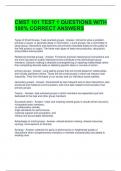CMST 101 TEST 1 QUESTIONS WITH
100% CORRECT ANSWERS
Types of Small Groups- Task-oriented groups - Answer- formed to solve a problem,
promote a cause, or generate ideas or information, n such groups, like a committee or
study group, interactions and decisions are primarily evaluated based on the quality of
the final product or output. The three main types of tasks are production, discussion,
and problem-solving tasks
Relational-oriented groups - Answer- Formed to promote interpersonal connections and
are more focused on quality interactions that contribute to the well-beingof group
members. Decision making is directed at strengthening or repairing relationships rather
than completing discrete tasks or debating specific ideas or courses of action.
primary groups - Answer- Long-lasting groups that are formed based on relationships
and include significant others. These are the small groups in which we interact most
frequently. They form the basis of our society and our individual social realities.
secondary groups - Answer- haracterized by less frequent face-to-face interactions, less
emotional and relational communication, and more task-related communication than
primary groups
Teams- - Answer- task-oriented groups in which members are especially loyal and
dedicated to the task and other group members
Successful team - Answer- •clear and inspiring shared goals,•a results-driven structure,
•competent team members,
•a collaborative climate,
•high standards for performance,
•external support and recognition, and
•ethical and accountable leadership.
Advantages of small groups - Answer- shared decision making, shared resources,
synergy, and exposure to diversity
Synergy - Answer- potential for gains in performance or heightened quality of
interactions when complementary members or member characteristics are added to
existing ones
,disadvantages to small group interaction. - Answer- one person can be just as or more
effective than a group of people, slow down the decision-making process, coordinating
and planning group meetings due to busy and conflicting schedules.
Small Group Development- Forming - Answer- group members begin to reduce
uncertainty associated with new relationships and/or new tasks through initial
interactions that lay the foundation for later group dynamics. sets the group on a
trajectory influenced by group members' feelings about one another and their purpose
or task.
Group cohesion - Answer- commitment of members to the purpose of the group and the
degree of attraction among individuals within the group
Small Group Development- Storming - Answer- Conflict emerges as group members
begin to perform their various roles, have their ideas heard, and negotiate where they fit
in the group's structure. Conflict is inevitable and important as a part of group
development and can be productive if it is managed properly.
Small Group Development- norming - Answer- The practices and expectations (norms
and rules) of the group are solidified, which leads to more stability, productivity, and
cohesion within the group.
Small Group Development- Performing - Answer- group members work relatively
smoothly toward the completion of a task or the achievement of their purpose, ideally
capitalizing on the synergy that comes from the diverse experiences group members
bring to the decision-making process.
Small Group Development- Adjourning - Answer- group dissolves because its purpose
has been met, because membership has declined or the group has lost support, or due
to some other internal or external cause. It is important that groups reflect on the life of
the group to learn any relevant lessons and celebrate accomplishments.
Group climate - Answer- relatively enduring tone and quality of group interaction that is
experienced similarly by group members.
Task cohesion - Answer- the commitment of group members to the purpose and
activities of the group.
Social cohesion - Answer- he attraction and liking among group members. I
Groups with an appropriate level of cohesiveness - Answer- •set goals easily;•exhibit a
high commitment to achieving the purpose of the group;
•are more productive;
•experience fewer attendance issues;
•have group members who are willing to stick with the group during times of difficulty;
•have satisfied group members who identify with, promote, and defend the group;
, •have members who are willing to listen to each other and offer support and
constructive criticism; and
•experience less anger and tension.
positive group climate - Answer- •Participation. Group members feel better when they
feel included in discussion and a part of the functioning of the group.
•Messages. Confirming messages help build relational dimensions within a group, and
clear, organized, and relevant messages help build task dimensions within a group.
•Feedback. Positive, constructive, and relevant feedback contribute to group climate.
•Equity. Aside from individual participation, group members also like to feel as if
participation is managed equally within the group and that appropriate turn taking is
used.
•Clear and accepted roles. Group members like to know how status and hierarchy
operate within a group. Knowing the roles isn't enough to lead to satisfaction, though—
members must also be comfortable with and accept those roles.
•Motivation. Member motivation is activated by perceived connection to and relevance
of the group's goals or purpose.
Types of Leadership Power- Expert power - Answer- Comes from knowledge, skill, or
expertise that a group member possesses and other group members do not.
Types of Leadership Power- Legitimate power - Answer- Power that flows from the
officially recognized position, status, or title of a group member.
Types of Leadership Power- Referent power - Answer- Comes from the attractiveness,
likeability, and charisma of the group member, and also derives from a person's
reputation.
Types of Leadership Power- Information power - Answer- Comes from a person's ability
to access information that comes through informal channels and well-established social
and professional networks.
Types of Leadership Power- Reward power - Answer- Comes from the ability of a group
member to provide a positive incentive as a compliance-gaining strategy.
Types of Leadership Power- Coercive power - Answer- Comes from the ability of a
group member to provide a negative incentive.
Maintenance Roles- Social-Emotional Leader - Answer- May perform a variety of
maintenance roles and is generally someone who is well liked by the other group
members and whose role behaviors complement but don't compete with the task leader.
Reflective thinker who has good perception skills that he or she uses to analyze the
group dynamics and climate and then initiate the appropriate role behaviors to maintain
a positive climate.





